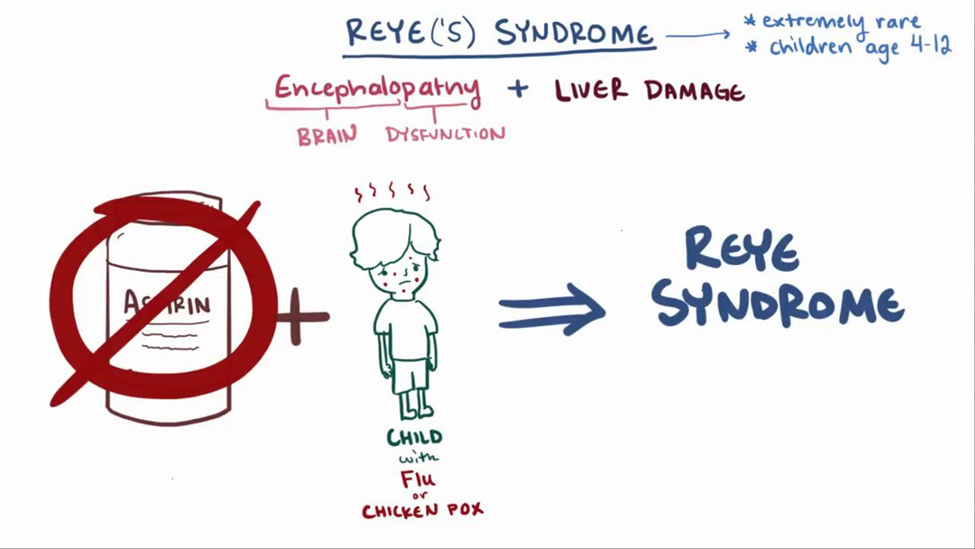A father presents to the emergency department with his 4 year old son. The father explains that his son had a fever, so he gave the child baby aspirin to decrease the fever and it has not worked. What should concern the nurse about a 4 year old receiving aspirin?
Aspirin has the potential to cause gastrointestinal (GI) bleeding in children
Aspirin has the potential to cause hyperglycemia
Aspirin has the potential to cause ringing in the ears in children
Aspirin has the potential to cause Reye's syndrome in children.
The Correct Answer is D
A. Aspirin has the potential to cause gastrointestinal (GI) bleeding in children.
While it is true that aspirin can cause GI bleeding, this is not the primary concern in this scenario. Reye's syndrome, a severe and potentially fatal condition, is the more significant worry when aspirin is given to children with viral infections.
B. Aspirin has the potential to cause hyperglycemia.
Hyperglycemia (high blood sugar) is not a known effect of aspirin in children. Aspirin is not typically associated with glucose metabolism issues.
C. Aspirin has the potential to cause ringing in the ears (tinnitus) in children.
Tinnitus can occur with aspirin use, but it is not the primary concern in this situation. Reye's syndrome is a more serious and immediate risk associated with aspirin use in children with viral infections.
D. Aspirin has the potential to cause Reye's syndrome in children.
This is the correct and most significant concern. Reye's syndrome is a rare but severe condition associated with aspirin use in children during or after viral infections. It affects the liver and brain and can be life-threatening.

Nursing Test Bank
Naxlex Comprehensive Predictor Exams
Related Questions
Correct Answer is C
Explanation
A. A learning disorder and muscle paralysis
This description does not align with the typical symptoms of ADHD. ADHD is characterized by core symptoms of inattention, hyperactivity, and impulsivity. Muscle paralysis is not a recognized symptom of ADHD.
B. Nervousness and sleeplessness
While some individuals with ADHD may experience difficulties with sleep, nervousness and sleeplessness are not the primary symptoms of ADHD. ADHD is more characterized by difficulties with attention, hyperactivity, and impulsivity.
C. Hyperactivity and decreased attention span
This is the correct choice. Hyperactivity and a decreased attention span are core symptoms of ADHD. Children with ADHD often display impulsive behaviors, have difficulty sustaining attention, and may be overly active.
D. Hyperactivity and nervousness
While hyperactivity is a common symptom of ADHD, nervousness is not typically described as a core symptom. ADHD is more characterized by impulsivity, hyperactivity, and attention difficulties.
Correct Answer is A
Explanation
A. Aspirin and warfarin
The combination of aspirin and warfarin poses a potential risk of increased bleeding and bruising. Both aspirin and warfarin are anticoagulants, and when used together, they can potentiate each other's effects, leading to a higher risk of bleeding events, including easy bruising.
B. Sulfasalazine and acetaminophen
Sulfasalazine is often used in the treatment of arthritis and inflammatory bowel disease, while acetaminophen is a commonly used pain reliever. There is no significant interaction between these two medications leading to increased bleeding or bruising.
C. Tolmetin and propranolol
Tolmetin is a nonsteroidal anti-inflammatory drug (NSAID) used for pain relief, and propranolol is a beta-blocker used for conditions such as hypertension. While both medications have their own potential side effects, there is no specific interaction between them that significantly increases the risk of bleeding or bruising.
D. Meloxicam and amlodipine
Meloxicam is an NSAID, and amlodipine is a calcium channel blocker used for hypertension. Similar to option C, there is no known significant interaction between these two medications that would lead to increased bleeding or bruising.
Whether you are a student looking to ace your exams or a practicing nurse seeking to enhance your expertise , our nursing education contents will empower you with the confidence and competence to make a difference in the lives of patients and become a respected leader in the healthcare field.
Visit Naxlex, invest in your future and unlock endless possibilities with our unparalleled nursing education contents today
Report Wrong Answer on the Current Question
Do you disagree with the answer? If yes, what is your expected answer? Explain.
Kindly be descriptive with the issue you are facing.
